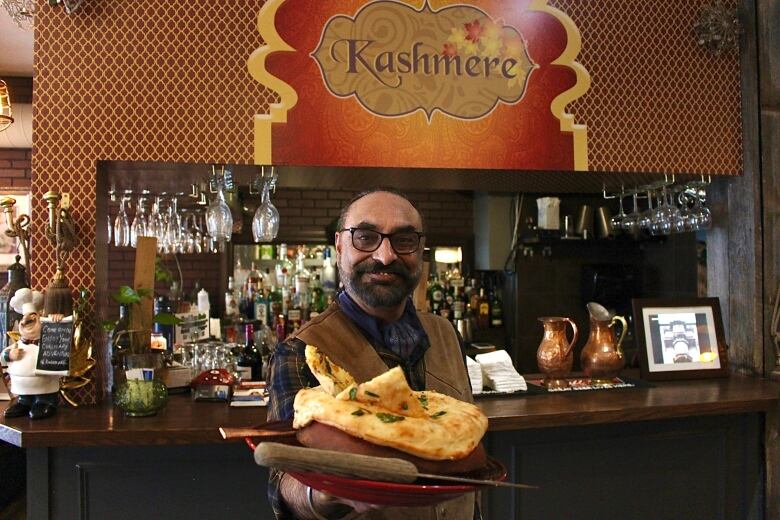Restaurant Kashmere encourages diners to 'try something other than butter chicken'
Local writer shares the stories behind Saskatoon's food scene, one bite at a time

This story originally published on Jan. 26, 2023.
Harinder Raifondly remembers his maternal grandmothertendingto a wood fired hearth that warmed a clay stove.
"That's my inspiration: sitting next to her while she was doing the cooking ... imagine those times."
Rai grew up in Kashmir, a northern geographical region in the Indian subcontinent. Kashmir is known for its picturesque valleys and mountain ranges, and its distinct cuisine, which has been shaped by this geography and a complex history of intertwining cultures.
Rai is proud to offer that cuisine in Saskatoon at Restaurant Kashmere, which he owns and operates alongside his wife, Sheena Rai, and their son, Inesh Rai.

Building the spice trail
After training at the Institute of Hotel Management in India, Rai spent several years working in the hospitality industry.
In 2008, he moved to Canada with his family, initially settlingin Montreal.
He later made a home in Prince Albert, Sask., where he opened his first restaurant, The Spice Trail, in 2015. He said there was no other Indian restaurant in the city at the time.
"I wanted to kind of educate or introduce people to Indian cuisine authentic Indian cuisine, not shortchanged Indian cuisine," he said.

Initially, Rai had no intention of opening a second restaurant, but when one of his regular customers was transferred to Saskatoon for work and enjoyed The Spice Trail's food so much he kept visiting Prince Albert just to chow down he put the bug in Rai's ear.
"He kept pestering me, 'You need to be in Saskatoon,'" Rai said.
He went so far as to drive Rai to Saskatoon to show him a spot on Broadway Avenue that was up for sale.
In 2019, Restaurant Kashmere opened at 820 Broadway Ave.

Last year, the Rai family opened House of Hakka in Saskatoon, which offers a fusion of Indian and Chinese cuisine.
Showcasing cuisine from Kashmir
Rai said that aromatic spices are at the heart of every recipe, adding flavour and complexity.
"Indian food is spicy, yes, but spice means flavour. It shouldn't be hot," he said, noting that the order in which spices are added to a dish is just as important as which ones are used.
Rai buys spices like coriander, turmeric and cinnamon whole, then roasts and grinds them every morning to create different blends for various dishes.
"That's why anyone who comes in says, 'How come this flavor is so enhanced?' Well, you got to work for it," said Rai.
Many of the menu items are cooked at very high temperatures in a tandoor, which is a large clay oven. Meat dishes like kebabs and drumsticks are placed on metal skewers and then grilled in the tandoor, while Indian flatbreads like naan and roti are baked along the clay walls.

Rai said many of the food traditions from Kashmir developed because the region is landlocked and has a shorter growing season. Dehydrated fruits and vegetables are staples, along with meat dishes, which are frequently cooked in yogurt to balance the flavours and tenderize the meat. The restaurant's goshtaba, which features meatballs in a yogurt and fennel-based sauce, is one example of this method.
Other menu items that are unique to Kashmir include rogan josh, a curried meat dish made with shallots, and chilman biryani layered rice, vegetables and meat, topped with naan. "Chilman" means veil or curtain: the biryani is draped in naan and slow-cooked in the oven, making it different from other variations of the dish. Rai says this cooking method gives the biryani "tremendous flavour."

If you're having difficulty deciding what to order first, Rai only hasone suggestion: "try something other than butter chicken."












_(720p).jpg)


 OFFICIAL HD MUSIC VIDEO.jpg)
.jpg)



























































































